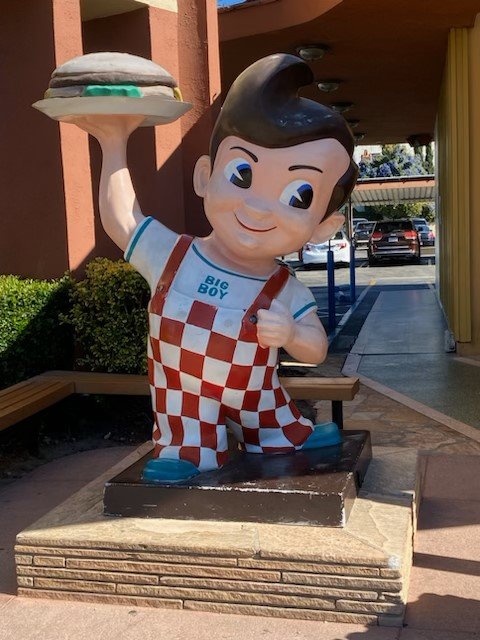by Pebbla Wallace
“Bob” Big Boy statue on Riverside Drive. Photo by Pebbla Wallace
No, I’m not talking about the 1991 comedy starring Bill Murray and Richard Dreyfuss. I’m referring to the iconic chubby-cheek boy with the Pompadour haircut of the 50s with red checkered overalls, who has guarded the Big Boy restaurant on Riverside Drive since 1949. Why is this Bob and the restaurant he stands in front of considered iconic? And why is the restaurant considered a “Point of Historical Interest” by the State of California? To understand that, you must first understand Bob’s history.
The Birth of Bob. The conception of “Bob” was first born in 1936 by founder Bob Wain, when Wain sold his car for $300 dollars and purchased a small ten-stool lunch stand in Glendale and called it Bob’s Pantry. According to Bob Big Boy’s historical blog, the new name came about when a young chubby boy with droopy overalls was doing odd jobs for Bob. He forgot the young boy’s name and called out “Hey, Big Boy,” and the new name was born – Bob’s Big Boy.
The Building – Interior and Exterior. Bob’s Big Boy restaurant on Riverside Drive opened in 1949, and today is the oldest operating Big Boy in the United States. The restaurant was designed by architect Wayne McAllister, and built by Burbank residents Scott MacDonald and Ward Albert. Wayne McAllister was a Southern California trailblazer at the time, specializing in Googie architecture – a style of futurist architecture that was influenced by car culture. According to the Los Angeles Conservancy, “the restaurant is a transitional design incorporating 1940s Streamline Moderne styles (broad, curving window walls and canopies) while anticipating the exuberance of freeform ‘50s coffee shop architecture (cantilevers, striking signage, use of glass)”.
The building’s most eye-catching aspect is the massive neon sign which soars above the restaurant, and is considered an art form by itself. The amazingly dramatic sign, which is more than 70 feet tall, has pink and white neon letters and is visible for miles down Riverside Drive and throughout the Toluca Lake and Burbank areas.
The restaurant started with both a drive-in and sit-down restaurant, and originally included carhop service (which was utilized again during the COVID-19 pandemic). Even though today it is no longer a drive-in, it still retains the drive-in features, with classic auto shows every Friday night. The interior of the restaurant has been remodeled several times, but the strategic seating plan, which placed the booths to have a panoramic view, has remained the same.
Big Boy’s Name to Fame. In 1965, The Beatles stopped by and dined at this particular Big Boy’s restaurant during one of their tours. A plaque commemorating the event marks a corner booth in the restaurant. If you go to the restaurant and try to get that booth – good luck; it is very popular and rarely available due to many regulars and tourists requesting the famous “Beatles booth.”
Bob’s Big Boy Carhop Service in 1954, LAPL Public Library
STOLEN, BOB-NAPPED, and DISMEMBERED
The “Bob” 300-pound fiberglass icon statues have been the victim of crime throughout the nation, and have notably been Bob-napped too many times to count. To this day, there is no record of any ransoms being paid for the retrieval of poor Bob. However, some examples of Bob-napping were in Wyoming when he was Bob-napped and abandoned in a field near the East Entrance to Yellowstone National Park. In Toledo, Ohio four youths stole and dismembered the Big Boy statue. They removed his arms and legs and left them in front of another fast-food restaurant. A note was left with letters cut from newspapers, reading “Big Boy is Dead”. In South Burlington, Vermont, Bob was kidnapped from its display outside, was shot in the head, and dumped in a nearby woods.
Bob isn’t the only fiberglass statue that has been kidnapped in the past – Ronald McDonald; a 700-pound captain with a parrot; a 4-foot Pillsbury doughboy; and a 250-pound dolphin from Marineland have all been victims of similar mascot-napping. Most law enforcement believe these were done as high school and College pranks. Nobody knows exactly how many times Bob has been stolen or kidnapped from the Burbank location – but today he is set in deep concrete. Please be warned – the Big Boy fiberglass icon is valued at over $6,000 – and bob-napping him is considered a felony in Los Angeles County.
But no matter how many times you try to Bob-nap or wound the iconic figure, he always bounces back. Yes, Bob has been in the fiberglass hospital many times for repairs, and yes, Bob has had a few facelifts since 1949 – a little paint here, and a small patch there. But he’ll always be there on Riverside Drive to welcome you to his restaurant.
At Big Boy’s Peak in the 1960s, owner Bob Wian had over 1,000 individual locations nationwide and hundreds of franchises. Wian sold the business to Marriott Corp. for $7 million in mid-1970 and later retired from the restaurant business. In 1988, Marriott sold the franchise rights to Elias Bros. However, the Burbank/Toluca Lake location is owned separately by the family of one of the original builders, Scott MacDonald, who acquired control of the restaurant in 1993.






